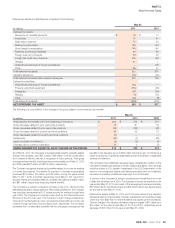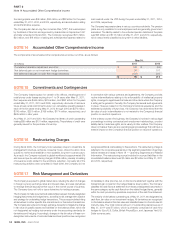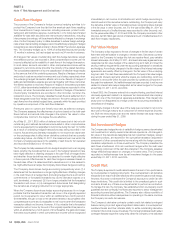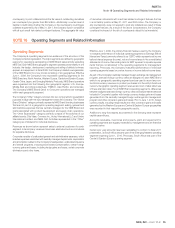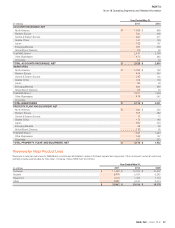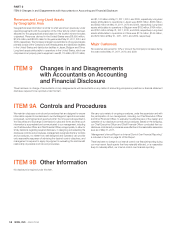Nike 2011 Annual Report Download - page 50
Download and view the complete annual report
Please find page 50 of the 2011 Nike annual report below. You can navigate through the pages in the report by either clicking on the pages listed below, or by using the keyword search tool below to find specific information within the annual report.
50 NIKE,INC.-Form10-K
PARTII
Note10Redeemable Preferred Stock
The Company does not anticipate that any foreign tax credit carry-forwards will expire. The Company has available domestic and foreign loss carry-forwards
of $183million at May31,2011. Such losses will expire as follows:
(Inmillions)
Year Ending May31,
2013 2014 2015 2016 2017-2028 Indefi nite Total
Net Operating Losses $ 7 $ 10 $ 4 $ 10 $ 91 $ 61 $ 183
During theyears ended May31,2011,2010, and 2009, income tax benefi ts attributable to employee stock-based compensation transactions of $68million,
$57million, and $25million, respectively, were allocated to shareholders’ equity.
NOTE10 Redeemable Preferred Stock
Sojitz America is the sole owner of the Company’s authorized Redeemable
Preferred Stock, $1 par value, which is redeemable at the option of Sojitz America
or the Company at par value aggregating $0.3million. A cumulative dividend
of $0.10 per share is payable annually on May31 and no dividends may be
declared or paid on the common stock of the Company unless dividends on
the Redeemable Preferred Stock have been declared and paid in full. There
have been no changes in the Redeemable Preferred Stock in the threeyears
ended May31,2011,2010, and 2009. As the holder of the Redeemable
Preferred Stock, Sojitz America does not have general voting rights but does
have the right to vote as a separate class on the sale of all or substantially all
of the assets of the Company and its subsidiaries, on merger, consolidation,
liquidation or dissolution of the Company or on the sale or assignment of the
NIKE trademark for athletic footwear sold in the UnitedStates.
NOTE11 Common Stock and Stock-Based Compensation
The authorized number of shares of ClassA Common Stock, no par value,
and ClassB Common Stock, no par value, are 175million and 750million,
respectively. Each share of ClassA Common Stock is convertible into one
share of ClassB Common Stock. Voting rights of ClassB Common Stock
are limited in certain circumstances with respect to the election of directors.
In 1990, the Board of Directors adopted, and the shareholders approved,
the NIKE,Inc. 1990 Stock Incentive Plan (the “1990 Plan”). The 1990 Plan
provides for the issuance of up to 163million previously unissued shares of
ClassB Common Stock in connection with stock options and other awards
granted under the plan. The 1990 Plan authorizes the grant of non-statutory
stock options, incentive stock options, stock appreciation rights, restricted
stock, restricted stock units, and performance-based awards. The exercise
price for stock options and stock appreciation rights may not be less than the
fair market value of the underlying shares on the date of grant. A committee
of the Board of Directors administers the 1990 Plan. The committee has
the authority to determine the employees to whom awards will be made,
theamount of the awards, and the other terms and conditions of the awards.
Substantially all stock option grants outstanding under the 1990 Plan were
granted in the fi rst quarter of each fi scal year, vest ratably over fouryears,
and expire 10years from the date of grant.
The following table summarizes the Company’s total stock-based compensation expense recognized in selling and administrative expense:
(inmillions)
Year Ended May31,
2011 2010 2009
Stock options(1) $ 77 $ 135 $ 129
ESPPs 14 14 14
Restricted stock 14 10 8
Subtotal 105 159 151
Stock options and restricted stock expense— restructuring(2) — — 20
TOTAL STOCK-BASED COMPENSATION EXPENSE $ 105 $ 159 $ 171
(1) Expense for stock options includes the expense associated with stock appreciation rights. Accelerated stock option expense is recorded for employees eligible for accelerated stock option vesting
upon retirement. In the first quarter of fiscal 2011, the Company changed the accelerated vesting provisions of its stock option plan. Under the new provisions, accelerated stock option expense
for year ended May31,2011 was $12million. The accelerated stock option expense for theyears ended May31,2010 and 2009 was $74million and $59million, respectively.
(2) In connection with the restructuring activities that took place during fiscal 2009, the Company recognized stock-based compensation expense relating to the modification of stock option
agreements, allowing for an extended post-termination exercise period, and accelerated vesting of restricted stock as part of severance packages. See Note16—Restructuring Charges for
further details.
As of May31,2011, the Company had $111million of unrecognized
compensation costs from stock options, net of estimated forfeitures, to be
recognized as selling and administrative expense over a weighted average
period of 2.2years.
The weighted average fair value per share of the options granted during theyears
ended May31,2011,2010, and 2009, as computed using the Black-Scholes
pricing model, was $17.68, $23.43, and $17.13, respectively. The weighted
average assumptions used to estimate these fair values are as follows:
Year Ended May31,
2011 2010 2009
Dividend yield 1.6% 1.9% 1.5%
Expected volatility 31.5% 57.6% 32.5%
Weighted average expected life (inyears) 5.0 5.0 5.0
Risk-free interest rate 1.7% 2.5% 3.4%
The Company estimates the expected volatility based on the implied volatility
in market traded options on the Company’s common stock with a term greater
than one year, along with other factors. The weighted average expected life
of options is based on an analysis of historical and expected future exercise
patterns. The interest rate is based on the U.S. Treasury (constant maturity)
risk-free rate in effect at the date of grant for periods corresponding with the
expected term of the options.











